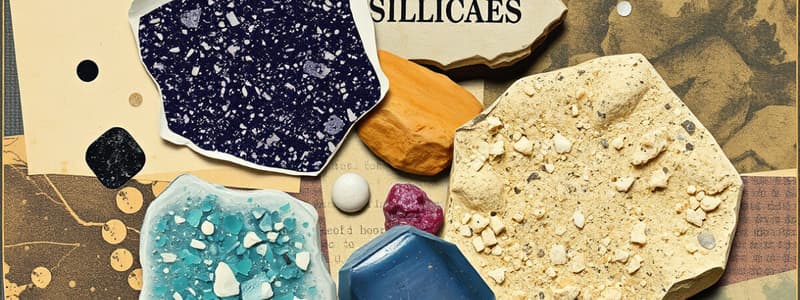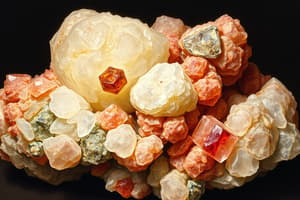Podcast
Questions and Answers
What are the two main groups that minerals are classified into?
What are the two main groups that minerals are classified into?
- Silicates and Non-silicates (correct)
- Organic and Inorganic
- Precious and Semi-precious
- Metals and Non-metals
How are minerals classified?
How are minerals classified?
They are classified into groups based on their composition.
Which of these two groups is more common?
Which of these two groups is more common?
- Silicates (correct)
- Non-silicates
What are silicate minerals?
What are silicate minerals?
Give an example of a silicate mineral.
Give an example of a silicate mineral.
What are the six non-silicate mineral groups?
What are the six non-silicate mineral groups?
What is an example of a Native Element?
What is an example of a Native Element?
What is an example of a Carbonate?
What is an example of a Carbonate?
What is an example of a Halide?
What is an example of a Halide?
What is an example of an Oxide?
What is an example of an Oxide?
What is an example of a Sulfate?
What is an example of a Sulfate?
What is an example of a Sulfide?
What is an example of a Sulfide?
What are the criteria that must be met for an object to be considered a mineral?
What are the criteria that must be met for an object to be considered a mineral?
What is Crystal Structure?
What is Crystal Structure?
What non-silicate mineral group reacts with acid?
What non-silicate mineral group reacts with acid?
What is luster?
What is luster?
What is streak?
What is streak?
Why is looking at a mineral's color not the best way to identify a mineral?
Why is looking at a mineral's color not the best way to identify a mineral?
What is fluorescence?
What is fluorescence?
What is phosphorescence?
What is phosphorescence?
What is double refraction?
What is double refraction?
Name a mineral that possesses the ability to double refract.
Name a mineral that possesses the ability to double refract.
Name a mineral that is magnetic.
Name a mineral that is magnetic.
What is Moh's Hardness Scale?
What is Moh's Hardness Scale?
How can you tell Halite and Calcite apart?
How can you tell Halite and Calcite apart?
How can you tell Fluorite and Quartz apart?
How can you tell Fluorite and Quartz apart?
What makes a gemstone different from other minerals?
What makes a gemstone different from other minerals?
What is a carat?
What is a carat?
What are the two types of mining?
What are the two types of mining?
Which type of mining is more expensive and more dangerous?
Which type of mining is more expensive and more dangerous?
What is reclamation?
What is reclamation?
What is diamond used for?
What is diamond used for?
What is graphite used for?
What is graphite used for?
What is gypsum used for?
What is gypsum used for?
What is halite used for?
What is halite used for?
What is gold used for?
What is gold used for?
Native Elements are composed of?
Native Elements are composed of?
Carbonates contain combinations of?
Carbonates contain combinations of?
Halides form when?
Halides form when?
Oxides form when?
Oxides form when?
Flashcards are hidden until you start studying
Study Notes
Mineral Classification
- Minerals are classified into two primary groups: Silicates and Non-Silicates.
- Classification is based on mineral composition.
Silicate Minerals
- Silicate minerals contain both silicon and oxygen; they are the more common group.
- Examples include Quartz and Feldspar.
Non-Silicate Mineral Groups
- Six groups of non-silicate minerals: Native Elements, Carbonates, Halides, Oxides, Sulfates, and Sulfides.
- Example of Native Element: Gold.
- Example of Carbonate: Calcite.
- Example of Halide: Halite/Fluorite.
- Example of Oxide: Magnetite.
- Example of Sulfate: Gypsum.
- Example of Sulfide: Pyrite.
Mineral Criteria
- To qualify as a mineral, a substance must be: naturally occurring, inorganic, solid, have a set chemical composition, and exhibit a crystal structure.
Crystal Structure
- Defined by the repeated arrangement of atoms.
Reactivity and Identification
- Carbonates are the non-silicate group that reacts with acid.
- Luster refers to how light reflects from a mineral's surface.
- Streak is the color of a mineral in powdered form; not always reliable for identification due to color variation.
Luminescence Properties
- Fluorescence is the ability of a mineral to glow differently under ultraviolet light.
- Phosphorescence allows minerals to glow after ultraviolet light is removed.
Refraction and Magnetism
- Double refraction involves bending light to produce a double image.
- Calcite is a mineral that demonstrates double refraction.
- Magnetite is a naturally magnetic mineral.
Moh's Hardness Scale
- Ranges from 1 (softest) to 10 (hardest), used to assess the hardness of minerals.
Distinguishing Minerals
- Calcite can be distinguished from Halite as it reacts with acid, while Halite tastes like salt.
- Quartz is harder than Fluorite; this is a distinguishing factor.
Gemstones
- Gemstones are rare, beautiful minerals that are valued for their aesthetics and durability.
- The weight of precious minerals is measured in carats; one carat is roughly equivalent to the weight of a carob bean.
Mining Types
- Two types of mining: Surface and Underground.
- Underground mining is typically more expensive and dangerous.
Reclamation
- Refers to the process of restoring mined land to its original condition.
Mineral Uses
- Diamonds are utilized in jewelry and tools.
- Graphite is commonly used in pencils and steel-making.
- Gypsum is used in wallboard production.
- Halite serves as salt for food seasoning/preservation and in chemical production.
- Gold is valuable for jewelry, coins, dentistry, and electronics.
Composition of Mineral Groups
- Native Elements consist of a single element.
- Carbonates are characterized by combinations of carbon and oxygen.
- Halides form when elements like fluorine, chlorine, iodine, or bromine combine with metals like sodium, potassium, or calcium.
Studying That Suits You
Use AI to generate personalized quizzes and flashcards to suit your learning preferences.



